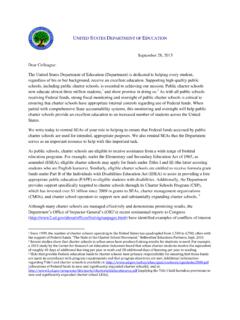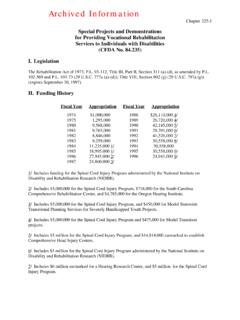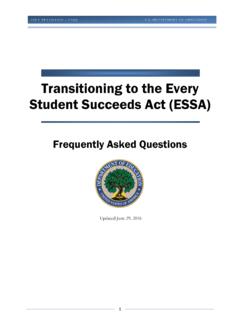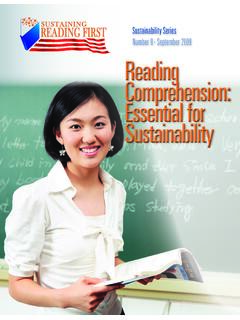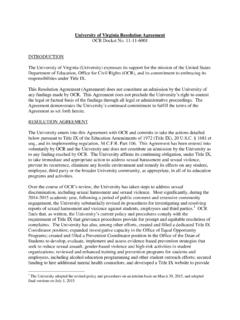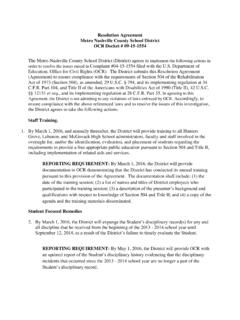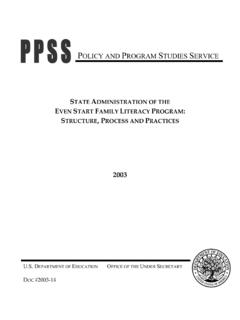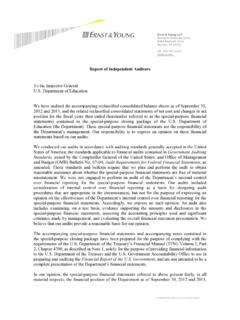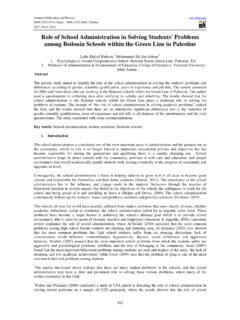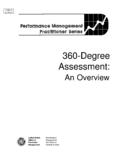Transcription of A Guide to the Individualized Education Program
1 Archived Information A Guide to the Individualized Education Program .. Office of Special Education and Rehabilitative Services Department of Education July 2000. Credits This Guide was developed by the Department of Education , with the assistance of the National Information Center for Children and Youth with Disabilities (NICHCY). The Department staff contributing to this Guide include: Debra Price-Ellingstad, JoLeta Reynolds, Larry Ringer, Ruth Ryder, and Suzanne Sheridan, under the direction of Judith E. Heumann, Kenneth Warlick, and Curtis Richards. Editor: Lisa K pper, NICHCY. Production: Jean Kohanek, NICHCY. Disability Art: Madison Moore, Additional copies of this Guide are available from: ED Pubs Editorial Publications Center Department of Education Box 1398. Jessup, MD 20794-1398. (877) 4-ED-PUBS. (877) 576-7734 TTY.
2 (301) 470-1244 Fax To obtain this publication in an alternate format (braille, large print, audio cassette, or disk), please contact Katie Mincey, Director of the Alternate Format Center, at (202) 260-9895, or via e-mail at This document is also available online at: ii Contents Introduction / 1. The Basic Special Education Process under IDEA / 2. A Closer Look at the IEP / 5. Contents of the IEP / 5. Additional State and School-System Content / 6. The IEP Team Members / 7. Writing the IEP / 10. Deciding Placement / 12. After the IEP Is Written / 13. Implementing the IEP / 13. Reviewing and Revising the IEP / 14. What If Parents Don't Agree With the IEP? / 15. Summary / 16. Sample IEP Form / 17. Information Resources / 23. Attachment A / 25. The federal regulations for Individualized Education Programs and additional guidance on the content of the IEP.
3 Iii Introduction Each public school child who receives special Education and related services must have an Individualized Education Program (IEP). Each IEP. must be designed for one student and must be a truly Individualized . document. The IEP creates an opportunity for teachers, parents, school administrators, related services personnel, and students (when appropriate) to work together to improve educational results for children with disabilities. The The Individualized IEP is the cornerstone of a quality Education for each child with a disability. Education Program is To create an effective IEP, parents, teachers, other school staff and often the cornerstone of the student must come together to look closely at the student's unique needs. a quality Education for These individuals pool knowledge, experience, and commitment to design an educational Program that will help the student be involved in, and progress in, each child with a the general curriculum.
4 The IEP guides the delivery of special Education disability. supports and services for the student with a disability. Without a doubt, writing and implementing an effective IEP requires teamwork . This Guide explains the IEP process, which we consider to be one of the Each public school most critical elements to ensure effective teaching, learning, and better results child who receives for all children with disabilities. The Guide is designed to help teachers, parents, and others in fact, anyone involved in the Education of a child with a special Education disability develop and carry out an IEP. The information in this Guide is and related services based on what is required by our nation's special Education law the under IDEA. Individuals with Disabilities Education Act, or IDEA. must have an IEP. The IDEA requires certain information to be included in each child's IEP.
5 It is useful to know, however, that states and local school systems often include . additional information in IEPs in order to document that they have met certain aspects of federal or state law. The flexibility that states and school systems have to design their own IEP forms is one reason why IEP forms may look different from school system to school system or state to state. Yet each IEP is critical in the Education of a child with a disability. 1. The Basic Special Education Process Under IDEA. The writing of each student's IEP takes place within the larger picture of the special Education process under IDEA. Before taking a detailed look at the IEP, it may be helpful to look briefly at how a student is identified as having a disability and needing special Education and related services and, thus, an IEP. Child is identified as Child Find.
6 The state must identify, locate, and evaluate all possibly needing special children with disabilities in the state who need special Education Education and related and related services. To do so, states conduct Child Find . services. activities. A child may be identified by Child Find, and parents may be asked if the Child Find system can evaluate their child. Parents can also call the Child Find system and ask that their child be evaluated. Or . Referral or request for evaluation. A school professional may ask that a child be evaluated to see if he or she has a disability. Parents may also contact the child's teacher or other school professional to ask that their child be evaluated. This request may be verbal or in writing. Parental consent is needed before the child may be evaluated. Evaluation needs to be completed within a reasonable time after the parent gives consent.
7 The evaluation must assess the child in all areas related to the Child is evaluated. child's suspected disability. The evaluation results will be used to decide the child's eligibility for special Education and related services and to make decisions about an appropriate educational Program for the child. If the parents disagree with the evaluation, they have the right to take their child for an Independent Educational Evaluation (IEE). They can ask that the school system pay for this IEE. A group of qualified professionals and the parents look at the Eligibility is decided. child's evaluation results. Together, they decide if the child is a child with a disability, as defined by IDEA. Parents may ask for a hearing to challenge the eligibility decision. If the child is found to be a child with a disability, as defined by Child is found eligible IDEA, he or she is eligible for special Education and related for services.
8 Services. Within 30 calendar days after a child is determined eligible, the IEP team must meet to write an IEP for the child. 2. The Basic Special Education Process Under IDEA. Once the student has been found eligible for services, the IEP must be written. The two steps below summarize what is involved in writing the IEP. This Guide will look at these two steps in much greater detail in the following section. The school system schedules and conducts the IEP meeting. School IEP meeting is scheduled. staff must: contact the participants, including the parents;. notify parents early enough to make sure they have an opportunity to attend;. schedule the meeting at a time and place agreeable to parents and the school;. tell the parents the purpose, time, and location of the meeting;. tell the parents who will be attending; and tell the parents that they may invite people to the meeting who have knowledge or special expertise about the child.
9 The IEP team gathers to talk about the child's needs and write the IEP meeting is held and student's IEP. Parents and the student (when appropriate) are part of the IEP is written. the team. If the child's placement is decided by a different group, the parents must be part of that group as well. Before the school system may provide special Education and related services to the child for the first time, the parents must give consent. The child begins to receive services as soon as possible after the meeting. If the parents do not agree with the IEP and placement, they may discuss their concerns with other members of the IEP team and try to work out an agreement. If they still disagree, parents can ask for mediation, or the school may offer mediation. Parents may file a complaint with the state Education agency and may request a due process hearing, at which time mediation must be available.
10 3. The Basic Special Education Process Under IDEA. Here is a brief summary of what happens after the IEP is written. The school makes sure that the child's IEP is being carried out as it was Services are provided. written. Parents are given a copy of the IEP. Each of the child's teachers and service providers has access to the IEP and knows his or her specific responsibilities for carrying out the IEP. This includes the accommodations, modifications, and supports that must be provided to the child, in keeping with the IEP. The child's progress toward the annual goals is measured, as stated in Progress is measured and the IEP. His or her parents are regularly informed of their child's reported to parents. progress and whether that progress is enough for the child to achieve the goals by the end of the year. These progress reports must be given to parents at least as often as parents are informed of their nondisabled children's progress.
